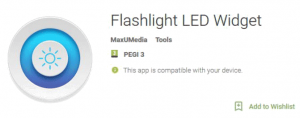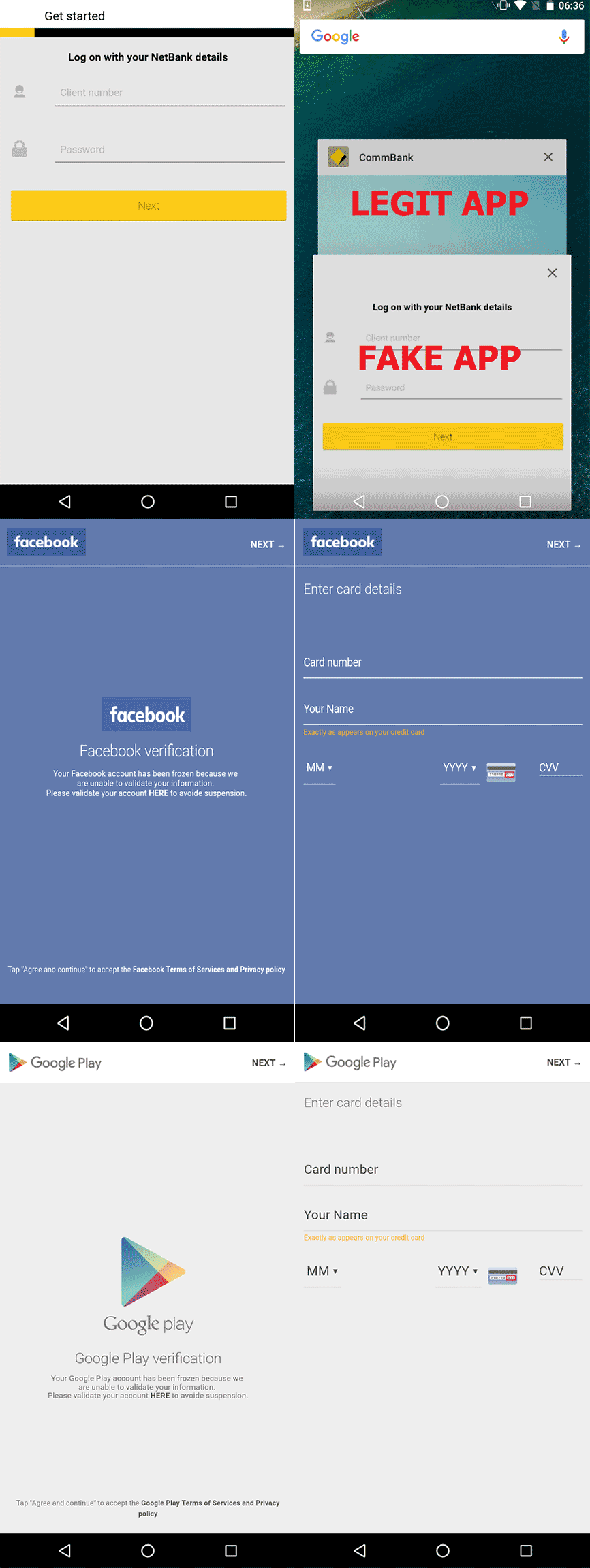 This article has been created to help you remove Flashlight LED Widget app that is actually malicious banking trojan that targets banking apps and may display phishing screens.
This article has been created to help you remove Flashlight LED Widget app that is actually malicious banking trojan that targets banking apps and may display phishing screens.
A remotely operated Trojan horse pretending to be a Flashlight application for Android devices has been reported to gain popularity and infect more devices. The trojan is able to display fake duplicate screens that appear to be the same as the ones on legitimate applications in order to intercept and steal information. This new type of phishing technique has been reported to be widely used and be the new trend in banking malware.

Threat Summary
| Name |
Flashlight LED Widget |
| Type | Android Banking Trojan |
| Short Description | Uses a fake app to display duplicate login screens of legitimate applications and sniff out information this way. |
| Symptoms | Having an app, called Flashlight LED Widget. |
| Distribution Method | Malicious third-party apps or Google Play Store. |
| Protection Tool |
See If Your System Has Been Affected by malware
Download
BetterGuard
|
| User Experience | Join our forum to Discuss El Gato Ransowmare. |

Flashlight Banking Trojan – Distribution
One very important method of distribution used by the hackers who spread this trojan is by uploading seemingly legitimate widgets and apps on Google Play store with malware embedded in them. The apps themselves are not malicious and they may do as promised, however this particular Flashlight LED Widget connects to a command and control server of the cyber-criminals after requesting administrative permissions from the Android user. Such permissions even allow the app to hide it’s icon from the device, preventing it’s uninstall via this method.

Android Flashlight Banking Trojan – How Does It Work?
Once the app infects an Android device, the payload is contained in encrypted format within the APK package file which the victim installs from the Google Play store. This payload code is obfuscated and cannot be detected. But once the application is installed, the code is unpacked and unlocked.
The first thing this trojan does is to connect to the server of the cyber-criminal behind it, sending important details of the device. It also takes a snapshot on your front camera to see who you are.
What is interesting is that if the device detects the victim is from Russia or former Soviet Union countries, including Ukraine and Belarus, it shuts down. This tactic is believed to be performed because the attackers may claim afterwards they have not infected their own countries.
In addition to those activities, the fake Flashlight LED Widget malware also sends information in a HTML code which is displayed in WebView. This means that as soon as the affected user opens a new application, the application that is original is replaced with a duplicate screen that requests victims to enter their personal credentials such as their PayPal password and username, for example. Malware researchers at WeLiveSecurity have identified that there is difference between the legitimate and fake screen, even though it is minimal:
Source: WeLiveSecurity
But this is not all, the malware can also lock the screen on your phone, similar to what mobile ransomware infections, like El Gato Android ransomware(https://sensorstechforum.com/remove-el-gato-android-ransomware-restore-locked-devices/) does.

Remove Flashlight Widget Banking Malware from Your Android Device
In order to make sure that your device is safe, follow the instructions below.
Preparation before removing Flashlight LED Widget.
Before starting the actual removal process, we recommend that you do the following preparation steps.
- Make sure you have these instructions always open and in front of your eyes.
- Do a backup of all of your files, even if they could be damaged. You should back up your data with a cloud backup solution and insure your files against any type of loss, even from the most severe threats.
- Be patient as this could take a while.
- Scan for Malware
- Fix Registries
- Remove Virus Files
Step 1: Scan for Flashlight LED Widget with SpyHunter Anti-Malware Tool



Step 2: Clean any registries, created by Flashlight LED Widget on your computer.
The usually targeted registries of Windows machines are the following:
- HKEY_LOCAL_MACHINE\Software\Microsoft\Windows\CurrentVersion\Run
- HKEY_CURRENT_USER\Software\Microsoft\Windows\CurrentVersion\Run
- HKEY_LOCAL_MACHINE\Software\Microsoft\Windows\CurrentVersion\RunOnce
- HKEY_CURRENT_USER\Software\Microsoft\Windows\CurrentVersion\RunOnce
You can access them by opening the Windows registry editor and deleting any values, created by Flashlight LED Widget there. This can happen by following the steps underneath:


 Tip: To find a virus-created value, you can right-click on it and click "Modify" to see which file it is set to run. If this is the virus file location, remove the value.
Tip: To find a virus-created value, you can right-click on it and click "Modify" to see which file it is set to run. If this is the virus file location, remove the value.Step 3: Find virus files created by Flashlight LED Widget on your PC.
1.For Windows 8, 8.1 and 10.
For Newer Windows Operating Systems
1: On your keyboard press + R and write explorer.exe in the Run text box and then click on the Ok button.

2: Click on your PC from the quick access bar. This is usually an icon with a monitor and its name is either “My Computer”, “My PC” or “This PC” or whatever you have named it.

3: Navigate to the search box in the top-right of your PC's screen and type “fileextension:” and after which type the file extension. If you are looking for malicious executables, an example may be "fileextension:exe". After doing that, leave a space and type the file name you believe the malware has created. Here is how it may appear if your file has been found:

N.B. We recommend to wait for the green loading bar in the navigation box to fill up in case the PC is looking for the file and hasn't found it yet.
2.For Windows XP, Vista, and 7.
For Older Windows Operating Systems
In older Windows OS's the conventional approach should be the effective one:
1: Click on the Start Menu icon (usually on your bottom-left) and then choose the Search preference.

2: After the search window appears, choose More Advanced Options from the search assistant box. Another way is by clicking on All Files and Folders.

3: After that type the name of the file you are looking for and click on the Search button. This might take some time after which results will appear. If you have found the malicious file, you may copy or open its location by right-clicking on it.
Now you should be able to discover any file on Windows as long as it is on your hard drive and is not concealed via special software.
Flashlight LED Widget FAQ
What Does Flashlight LED Widget Trojan Do?
The Flashlight LED Widget Trojan is a malicious computer program designed to disrupt, damage, or gain unauthorized access to a computer system. It can be used to steal sensitive data, gain control over a system, or launch other malicious activities.
Can Trojans Steal Passwords?
Yes, Trojans, like Flashlight LED Widget, can steal passwords. These malicious programs are designed to gain access to a user's computer, spy on victims and steal sensitive information such as banking details and passwords.
Can Flashlight LED Widget Trojan Hide Itself?
Yes, it can. A Trojan can use various techniques to mask itself, including rootkits, encryption, and obfuscation, to hide from security scanners and evade detection.
Can a Trojan be Removed by Factory Reset?
Yes, a Trojan can be removed by factory resetting your device. This is because it will restore the device to its original state, eliminating any malicious software that may have been installed. Bear in mind that there are more sophisticated Trojans that leave backdoors and reinfect even after a factory reset.
Can Flashlight LED Widget Trojan Infect WiFi?
Yes, it is possible for a Trojan to infect WiFi networks. When a user connects to the infected network, the Trojan can spread to other connected devices and can access sensitive information on the network.
Can Trojans Be Deleted?
Yes, Trojans can be deleted. This is typically done by running a powerful anti-virus or anti-malware program that is designed to detect and remove malicious files. In some cases, manual deletion of the Trojan may also be necessary.
Can Trojans Steal Files?
Yes, Trojans can steal files if they are installed on a computer. This is done by allowing the malware author or user to gain access to the computer and then steal the files stored on it.
Which Anti-Malware Can Remove Trojans?
Anti-malware programs such as SpyHunter are capable of scanning for and removing Trojans from your computer. It is important to keep your anti-malware up to date and regularly scan your system for any malicious software.
Can Trojans Infect USB?
Yes, Trojans can infect USB devices. USB Trojans typically spread through malicious files downloaded from the internet or shared via email, allowing the hacker to gain access to a user's confidential data.
About the Flashlight LED Widget Research
The content we publish on SensorsTechForum.com, this Flashlight LED Widget how-to removal guide included, is the outcome of extensive research, hard work and our team’s devotion to help you remove the specific trojan problem.
How did we conduct the research on Flashlight LED Widget?
Please note that our research is based on an independent investigation. We are in contact with independent security researchers, thanks to which we receive daily updates on the latest malware definitions, including the various types of trojans (backdoor, downloader, infostealer, ransom, etc.)
Furthermore, the research behind the Flashlight LED Widget threat is backed with VirusTotal.
To better understand the threat posed by trojans, please refer to the following articles which provide knowledgeable details.




